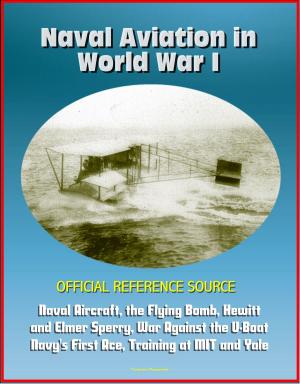An Operational Analysis of the Pearl Harbor Attack: World War II Deception to Achieve Surprise, Reconnaissance and Intelligence Execution, Admiral Yamamoto, Japanese Aircraft Carriers Akaqi and Kaga
Nonfiction, History, Asian, Japan, Military, World War II| Author: | Progressive Management | ISBN: | 9781310813115 |
| Publisher: | Progressive Management | Publication: | May 11, 2016 |
| Imprint: | Smashwords Edition | Language: | English |
| Author: | Progressive Management |
| ISBN: | 9781310813115 |
| Publisher: | Progressive Management |
| Publication: | May 11, 2016 |
| Imprint: | Smashwords Edition |
| Language: | English |
Professionally converted for accurate flowing-text e-book format reproduction, this book explores the Pearl Harbor attack from an operational level of war perspective. Its purpose is to provide the reader with a Japanese viewpoint of the Pearl Harbor operation, and to determine if there were weaknesses with the plan and its execution. The study is limited in scope in that it will focus primarily on a single operation of the Pacific campaign initiated by the Japanese.
Much has been written about the devastation inflicted upon U.S. forces by Japan on 7 December 1941. Research initiated for this paper concludes that although the execution of the Pearl Harbor operation was successful, the operation did not achieve its strategic aim. A mismatch existed between operational and strategic objectives which was partially attributed to flaws in target selection, priority, and tactical level decision making during execution. Japan's narrow objective of destroying primarily capital ships, spared important logistical facilities from destruction. These support facilities proved to be the key to a quick restoration of U.S. naval presence in the region. Likewise, Japan's emphasis on placing a higher target priority for battleships versus carriers, allowed a more potent weapon system to essentially escape unscathed. This mistake had strategic implications in that aircraft carriers were the key weapon's platform used to destroy the Japanese Navy in later battles in the Pacific. Finally, the tactical commander's failure to exploit America's military forces at its most vulnerable point, minimized further damaged which could have been inflicted upon the U.S. Pacific Fleet anchored at Pearl Harbor. These operational and tactical errors allowed America to quickly recover from the attack and pursue offensive actions in the Pacific within a few months. The net result of the Pearl Harbor attack along with subsequent operations, solidified Japan's position in the Southwest Pacific. However, flaws in operational planning and conservative military leadership during the plan's execution, guaranteed this dominance only in the short term.
From the Japanese perspective, war with the United States seemed inevitable. During the early 1900's, the Japanese government spent a considerable amount of their national budget building a formidable navy. Her contributions to the allied side during World War I was rewarded by receiving Germany's island possessions in the Pacific, north of the equator. Therefore, Japan emerged from the war as a naval power with enhanced prestige and an appetite for "primary influence" in the western Pacific region. The Japanese island possessions were strategically located close to U.S. controlled islands in the Pacific thus, a rivalry with America quickly ensued.
In 1918, the Imperial Defense Policy adopted by Japan identified the United States as their number one potential enemy. This belief influenced all aspects of Japanese naval policy. A naval arms race resulted from increased tensions between the two nations. The Washington Agreement in 1922 deterred further escalation by limiting the number of ships each side could possess. The agreement and subsequent disarmament conferences, kept the size of the Japanese Navy inferior to United States naval forces. By 1936, Japan had withdrawn from the agreement, giving herself freedom to expand her navy. By 1941, the Japanese Navy "was more powerful than the combined British and United States fleets in the Pacific area."
Professionally converted for accurate flowing-text e-book format reproduction, this book explores the Pearl Harbor attack from an operational level of war perspective. Its purpose is to provide the reader with a Japanese viewpoint of the Pearl Harbor operation, and to determine if there were weaknesses with the plan and its execution. The study is limited in scope in that it will focus primarily on a single operation of the Pacific campaign initiated by the Japanese.
Much has been written about the devastation inflicted upon U.S. forces by Japan on 7 December 1941. Research initiated for this paper concludes that although the execution of the Pearl Harbor operation was successful, the operation did not achieve its strategic aim. A mismatch existed between operational and strategic objectives which was partially attributed to flaws in target selection, priority, and tactical level decision making during execution. Japan's narrow objective of destroying primarily capital ships, spared important logistical facilities from destruction. These support facilities proved to be the key to a quick restoration of U.S. naval presence in the region. Likewise, Japan's emphasis on placing a higher target priority for battleships versus carriers, allowed a more potent weapon system to essentially escape unscathed. This mistake had strategic implications in that aircraft carriers were the key weapon's platform used to destroy the Japanese Navy in later battles in the Pacific. Finally, the tactical commander's failure to exploit America's military forces at its most vulnerable point, minimized further damaged which could have been inflicted upon the U.S. Pacific Fleet anchored at Pearl Harbor. These operational and tactical errors allowed America to quickly recover from the attack and pursue offensive actions in the Pacific within a few months. The net result of the Pearl Harbor attack along with subsequent operations, solidified Japan's position in the Southwest Pacific. However, flaws in operational planning and conservative military leadership during the plan's execution, guaranteed this dominance only in the short term.
From the Japanese perspective, war with the United States seemed inevitable. During the early 1900's, the Japanese government spent a considerable amount of their national budget building a formidable navy. Her contributions to the allied side during World War I was rewarded by receiving Germany's island possessions in the Pacific, north of the equator. Therefore, Japan emerged from the war as a naval power with enhanced prestige and an appetite for "primary influence" in the western Pacific region. The Japanese island possessions were strategically located close to U.S. controlled islands in the Pacific thus, a rivalry with America quickly ensued.
In 1918, the Imperial Defense Policy adopted by Japan identified the United States as their number one potential enemy. This belief influenced all aspects of Japanese naval policy. A naval arms race resulted from increased tensions between the two nations. The Washington Agreement in 1922 deterred further escalation by limiting the number of ships each side could possess. The agreement and subsequent disarmament conferences, kept the size of the Japanese Navy inferior to United States naval forces. By 1936, Japan had withdrawn from the agreement, giving herself freedom to expand her navy. By 1941, the Japanese Navy "was more powerful than the combined British and United States fleets in the Pacific area."















